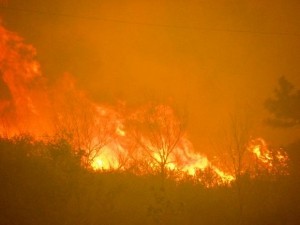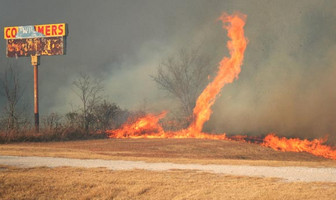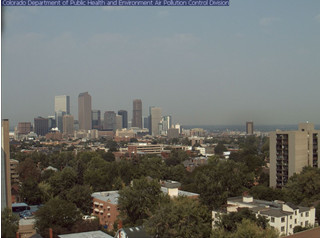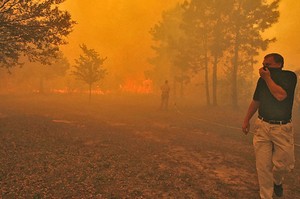Colorado’s deadly and dangerous fire season continues to worsen as a new fire burning west of Colorado Springs rages out of control. The Waldo Canyon Fire has grown to more than 2,000 acres in less than 24 hours and forced the evacuation of the entire town of Manitou Springs.
Tag Archives: wildfires
Colorado governor bans open burning, personal fireworks

Colorado Gov. John Hickenlooper today issued an executive order banning all open burning and the use of personal fireworks across the state. As the High Park Fire shows, conditions are tinder dry and while lightning was the cause of that blaze, man is often to blame for wildfires as well.
“We can’t completely eliminate the threat of wildfire because there’s no way to control Mother Nature,” Hickenlooper said in a statement. “But we can take steps to reduce the risks of more wildfires starting. This ban is a necessary step to help protect people, property and the beautiful state we live in.”
The ban will put a damper on 4th of July fireworks festivities but is a necessary step to protect life and property. For campers, there will be limitations in unimproved locations but fires in permanent pits within developed campgrounds will still be allowed as long as the local authority allows it.
You can read Gov. Hickenloopers statement here and the full text of the executive order here.
The High Park Fire now ranks as the third largest blaze in Colorado history. In 96 short hours the blaze grew to encompass an area more than 72 square miles and is now only 10% contained and still growing.
Related fire links:
By the numbers: Largest wildfires in Colorado history
Wildfires are a fact of life in the west burning hundreds of thousands of acres each year causing millions of dollars of damage and oftentimes claiming lives. With nearly half of the state’s land area comprising forest, Colorado…
High Park Fire explodes to 36,930 acres, more evacuations ordered
In only 48 hours a wildfire burning west of Fort Collins, Colorado has virtually exploded to encompass an area of more than 57 square miles. The High Park Fire is burning out of control with no containment as thousands of…
Ranking the top 10 Colorado weather events of the past 10 years

There is a lot that can be said about the weather in Colorado but ‘boring’ is not usually a term associated with it. Anyone who has lived in the Centennial State for very long quickly experiences a weather-related event that will give them memories for a lifetime.
From major snowstorms and blizzards to tornadoes, wildfires, scorching heat and damaging hail storms Colorado weather can and does bring it all to the table. The Denver office of the National Weather Service has released a list of what local meteorologists rank as the top 10 weather events of the past 10 years.
For some it may be a blizzard that buried the Mile High City in a heavy blanket of snow and brought everything to a standstill. Others will remember the heavy smoke from fires burning in the mountains destroying hundreds of thousands of acres. The tragedy tornadoes bring to Colorado in terms of destruction and loss of life may be what others remember.
Over the past 10 years many memorable weather events have occurred that fully display the sheer variety of weather Colorado receives. A team of meteorologists serving Colorado analyzed these events and ranked them based on meteorological intensity and their human and economic impact.
Continue reading Ranking the top 10 Colorado weather events of the past 10 years
Brazilian wildfire spawns fire tornado

Dry conditions, abundant fuel and strong winds create dangerous wildfire conditions. When in the right combination, a rare event – a fire tornado – can occur and one was captured on video in Brazil yesterday.
Coloradoans are not strangers to the dangers of wildfires. A relatively wet winter and summer has allowed us to escape relatively unscathed so far this year. Other parts of the globe however have not been so lucky.
In Russia, fires have burned hundreds of thousands of acres and sent plumes of smoke thousands of miles from western Russia to Siberia. The smoke has been so extensive it can be seen by NASA satellites 22,300 miles above the Earth.
Brazil as well has seen extensive wildfire activity in the last few weeks due to a drought. The brush fires have been fueled by the dry brush and they have devastated open land and destroyed homes.
Videographers filming near the city of Aracatuba in the Brazilian state of Sao Paolo captured a fire tornado yesterday as it tore through a Brazilian field. The rare event results when hot air on the surface rises and is twisted by winds thus pulling the fire vertically.
Fires across Russia spotted by NASA satellites

More than 600 wildfires burning across Russia have clouded the skies and claimed the lives of at least 50 people. NASA has trained its satellites on the nation capturing imagery of the blazes as they continue to burn.
Seven regions of Russia are under state of emergency as officials struggle to gain an upper hand against the fires. All told, estimates are that more than 484,000 acres (196,000 hectares) have been scorched with no end in sight.
President Dmitry Medvedev fired several military officials today for their inability to slow the fires. Thousands of people have lost their homes as the flames continue unabated. A naval base in Kolomna was destroyed last week and a nuclear research facility in Sarov is now threatened.
The choking smoke over places like Moscow has added to the misery of what has been an unusually hot summer. The plumes of smoke are so extensive they can easily be captured by NASA satellites orbiting 22,300 miles above the surface of the Earth.
The imagery below was captured by NASA’s Terra satellite yesterday. In the top image, the plumes of smoke from the fires in western Russia stretch more than 1,800 miles (3,000 km). The lower image shows a closer view of the fires burning southeast of Moscow.
Satellite image showing the extent of the smoke plume from fires burning in Russia (NASA)

Satellite image of smoke from wildfires burning southeast of Moscow (NASA)
.jpg)
Intense fires continued to rage in western Russia on August 4, 2010. Burning in dry peat bogs and forests, the fires produced a dense plume of smoke that reached across hundreds of kilometers. The Moderate Resolution Imaging Spectroradiometer (MODIS) captured this view of the fires and smoke in three consecutive overpasses on NASA’s Terra satellite. The smooth gray-brown smoke hangs over the Russian landscape, completely obscuring the ground in places. The top image provides a close view of the fires immediately southeast of Moscow, while the lower image shows the full extent of the smoke plume.
The fires along the southern edge of the smoke plume near the city of Razan, top image, are among the most intense. Outlined in red, a line of intense fires is generating a wall of smoke. The easternmost fire in the image is extreme enough that it produced a pyrocumulus cloud, a dense towering cloud formed when intense heat from a fire pushes air high into the atmosphere.
The lower image shows the full extent of the smoke plume, spanning about 3,000 kilometers (1,860 miles) from east to west. If the smoke were in the United States, it would extend approximately from San Francisco to Chicago. The MODIS sensor acquired the right section of the image starting at 5:55 UTC (10:55 a.m. local time, 8:55 a.m. in Moscow). The center section is from the overpass starting at 7:35 UTC (11:35 local time, 10:35 in Moscow), and the westernmost section was taken at 9:10 UTC (12:10 p.m. local time in Moscow).
Early analyses of data from the Multi-angle Imaging Spectroradiometer (MISR), another instrument on the Terra satellite, indicates that smoke from previous days has at times reached 12 kilometers (six miles) above Earth’s surface into the stratosphere. At such heights, smoke is able to travel long distances to affect air quality far away. This may be one reason that the smoke covers such a large area. The pyrocumulus cloud and the detection of smoke in the stratosphere are good indicators that the fires are large and extremely intense.
According to news reports, 520 fires were burning in western Russia on August 4. MODIS detected far fewer. It is likely that the remaining fires were hidden from the satellite’s view by the thick smoke and scattered clouds. High temperatures and severe drought dried vegetation throughout central Russia, creating hazardous fire conditions in July.
As of August 4, 48 people had died in the fires and more than 2,000 had lost their homes throughout central Russia, said news reports. The dense smoke also created hazardous air quality over a broad region. Visibility in Moscow dropped to 20 meters (0.01 miles) on August 4, and health officials warned that everyone, including healthy people, needed to take preventative measures such as staying indoors or wearing a mask outdoors, reported the Wall Street Journal. In the image, Moscow is hidden under a pall of smoke. Close to the fires, smoke poses a health risk because it contains small particles (soot) and hazardous gases that can irritate the eyes and respiratory system. Smoke also contains chemicals that lead to ozone production farther away from the fires.
The large image provides the full scene shown in the lower image at the sensor’s highest resolution (as shown in the top image). The MODIS Rapid Response Team provides the scene in additional resolutions.
References
- BBC News. (2010, August 4). Medvedev cuts holiday as Russian wildfires kill 48. Accessed August 4, 2010.
- Iosebashvili, I. (2010, August 4). Death toll rises as Russian fires rage. Wall Street Journal. Accessed August 4, 2010.
NASA image courtesy Jeff Schmaltz, MODIS Rapid Response Team at NASA GSFC. Caption by Holli Riebeek with information courtesy Mike Fromm, Naval Research Laboratory.
Russians caught in raging wildfire – Amazing video

Wildfires have been sweeping across European Russia in recent days prompting the government to declare a state of emergency. A recently released video shows how the fast moving blazes can turn a relatively calm situation into a desperate flight – and flight – for life in the face of advancing flames.
The video, released on YouTube, shows volunteers that went to the village of Tamboles to assist residents finding themselves instead in need of help.
The translated caption for the video explains that the vehicle’s occupants passed along the same road a half hour before and there was no hint of the fire. When they went to return, they were surrounded by flames as trees and brush burned around them and they were confronted with walls of flame.
Listening to the audio in the video one does not have to speak Russian to understand the desperateness of the situation they are in. Amazingly enough, the vehicle and its occupants survived their fiery journey.
Western wildfires send smoke over Colorado – Health warning issued

Update, 5:30pm – The Colorado Department of Public Health and Environment has issued a smoke health advisory for northwest and north-central Colorado. The department warns that residents may wish to limit outside activity, particularly those with heart disease, respiratory illnesses, the very young, and the elderly.
Read the advisory in its entirety at the bottom of this story.
Original post, 9/1/09, 3:54pm: The hazy, orange tinted skies over Denver on Monday were an unusual sight and a result of smoke traveling hundreds of miles from wildfires across the western United States. Satellite imagery released by NASA and the National Oceanic and Atmospheric Administration (NOAA) showed plumes of smoke moving northwest toward Colorado from as far away as Los Angeles.
The National Interagency Fire Center (NIFC) reported 17 fires burning in states from Colorado west. Seven fires in California, three in Utah and two in Colorado are the primary ones causing smoke over the Mile High City.
The largest of the blazes, the Station Fire in the foothills near Los Angeles, exploded to more than 120,000 acres in recent days. In Utah, the Mill Flats Fire burning in the Dixie National Forest grew to more than 10,000 acres.
Colorado reports two wildfires, the largest of which has been dubbed the Tabaguache Creek Fire in the Uncompahgre and Gunnison National Forests. That blaze is six miles north of Nucla and has scorched 1,260 acres.
Altogether, the fires that are actively burning have burned more than 150,000 acres of land. For the entire fire season which runs during the calendar year, 65,140 wildfires have been reported and an estimated 5,303,691 acres – more than 8,000 square miles – have been burned.
Tuesday the smoke has eased some over the Front Range and it should dissipate this evening.
From the Colorado Department of Public Health and Environment:
COLORADO SMOKE ADVISORY & OUTLOOK:
Significant smoke from fires in Canada, Utah, Colorado, California and other western states will cause widespread haze in Colorado on Tuesday and from time-to-time this week. Fine Particulate levels are in the Unhealthy-for-Sensitive-Groups category in Garfield County and are probably in the Unhealthy-for-Sensitive-Groups range in other areas across Northwest and North-central Colorado due to the smoke from the forest fires. The highest concentrations are expected to occur in Northwest and North-central Colorado, generally north of I-70, possibly as far east as the Front Range. Much of the rest of Colorado will see concentrations in the Moderate range. IF VISIBILITY IS LESS THAN 5 MILES IN SMOKE IN YOUR NEIGHBORHOOD, SMOKE HAS REACHED LEVELS THAT ARE UNHEALTHY. If smoke is thick or becomes thick in your neighborhood you may want to remain indoors. This is especially true for those with heart disease, respiratory illnesses, the very young, and the elderly. Consider limiting outdoor activity when moderate to heavy smoke is present. Consider relocating temporarily if smoke is present indoors and is making you ill. Smoke should gradually diminish later this evening in most areas.
For satellite analysis of smoke over the U.S., visit: http://www.firedetect.noaa.gov/viewer.htm
Moderate to heavy smoke is also possible in the vicinity of a fire 6 miles north of Nucla, especially in areas down-valley of the fire during the nighttime and morning hours.
FRONT RANGE AIR QUALITY FORECAST:
Ozone is expected to be in the Moderate to Unhealthy-for-Sensitive-Groups range Tuesday afternoon and evening (with the highest readings in the Denver metro area) and in the Moderate category on Wednesday. Active children, active adults, and people with respiratory illnesses should limit prolonged outdoor exertion from 2 PM until midnight tonight.
Visibility is expected to remain in the Poor Category on Tuesday and Wednesday.
Carbon monoxide levels are expected to remain in the Good category along the Front Range on Tuesday.
Fine particulate matter levels are expected to be in the Moderate category along the Front Range on Tuesday and Wednesday
Climate change to bring more wildfires to the Rockies

Sounding the warning sirens about the potential repercussions of global warming, Harvard scientists announced their belief that the changing climate will result in a 50% increase in the amount of land burned by wildfires by 2050. Should the predictions come true, the increased smoke from an increase in fires could have the effect of further accelerating warming.
Atmospheric scientists from Harvard’s School of Engineering and Applied Sciences (SEAS) have generated models that show much of the western half of the United States being at much greater risk from wildfires. The study, published in the Journal of Geophysical Research, is said to be the first to measure the impact of future wildfires on air quality.
SEAS Senior Research Fellow Jennifer Logan said, “Warmer temperatures can dry out underbrush, leading to a more serious conflagration once a fire is started by lightning or human activity. Because smoke and other particles from fires adversely affect air quality, an increase in wildfires could have large impacts on human health.”




 We offer in depth coverage of the wildfires and other climate and weather topics on our Denver Weather Examiner pages. Check it out!
We offer in depth coverage of the wildfires and other climate and weather topics on our Denver Weather Examiner pages. Check it out!